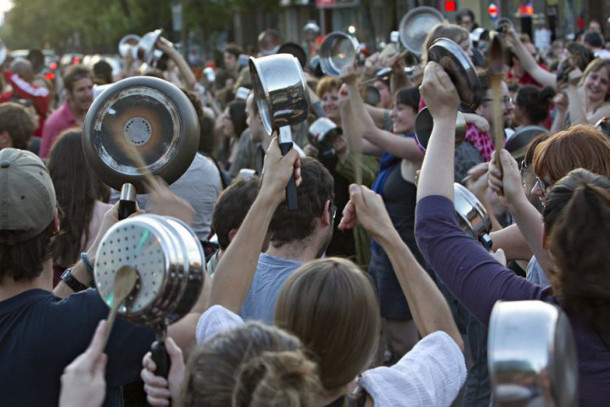"You and I travel to the beat of a different drum." -- Linda Ronstadt
As the clock struck 8 p.m. on a Montréal spring night in May 2012, a sound rose like crickets at dusk: a metallic tapping in the distance that multiplied and spread until a cacophony of clanging pots and pans filled the air.
All over the city, tens of thousands of people took to the streets that night, and for many nights to follow, armed with kitchenware. It was the largest pot-banging protest -- cacerolazo in Spanish, les casseroles in French -- that North America had ever seen.
As a protest tactic, the cacerolazo first gained international prominence in the 1970s, emerging as a powerful means of expressing popular dissent under brutal repression in Chile during the U.S.-backed military dictatorship of Augusto Pinochet. It again came to prominence during Argentina's neoliberal financial crisis in 2001. The tactic was widely deployed in Québec during the student strike in 2012, and again in Turkey the following year during mass protests against widespread government corruption and police repression.
Given its auditory force, a cacerolazo of sufficient size can be incredibly effective in drawing people into the streets, and massing them in public spaces. It also costs nothing and requires no previous activist training or skills. A cacerolazo is driven by shared discontent; the tactic is fundamentally participatory and democratic. People can also participate without hitting the streets, just by leaning out their window and banging a pot and pan in solidarity.
Given the speed and spontaneity with which the tactic can spread, and the resulting clamor, a successful cacerolazo is disorienting to police forces attempting to control the protests.
A cacerolazo protest is versatile and decentralized. It can be deployed during mass street demonstrations, but can also be used as a disruptor, say, for example, at a politician's press conference, or a corporate luncheon. Musically, it can range from a noisy, chaotic free-for-all to more coordinated rhythms. The tactic appeals to all ages and is particularly popular with children, who love banging pots and pans together even more than adults do.
CACEROLAZO BASICS
What is it? A pot-banging protest.
Common uses: To express popular dissent; to overcome fear in repressive settings; to draw wide swaths of the population into active participation in civil disobedience.
Key principle: Everyone can participate in a cacerolazo. It provides a framework of protest that is both easy to join and easy to spread and, in certain contexts, also seriously subversive. During the Québec student strike, calls for people to organize or join nightly casseroles protests in many different neighbourhoods spread by word of mouth, text messages and social media. Ultimately, hundreds of thousands of people participated in the nightly actions, a key factor in forcing the government to reverse its tuition hike.
Potential pitfalls: Some critics, while acknowledging the excellent collaborative, creative and disruptive qualities of the cacerolazo, point out that in a revolutionary context, the tactic can serve as a less challenging and potentially less effective alternative to more instrumental actions, such as bank blockades or a general strike. However, it's important to consider the broader social and political context within which cacerolazos are taking place. In a repressive context like the Québec student strike (when government authorities passed a law making street protests illegal), or under the terror and extreme repression of Pinochet's 1970s regime in Chile, spontaneous cacerolazos served as an antidote to fear and drew wide swaths of the population into active participation in civil disobedience.
Adapted from Beautiful Trouble with permission. To learn more about the project, go here
Please note our comment threads will be closed Dec. 22 to Jan. 5 to give our moderators a well-deserved break. Happy holidays, readers. ![]()
Read more: Rights + Justice, Politics















